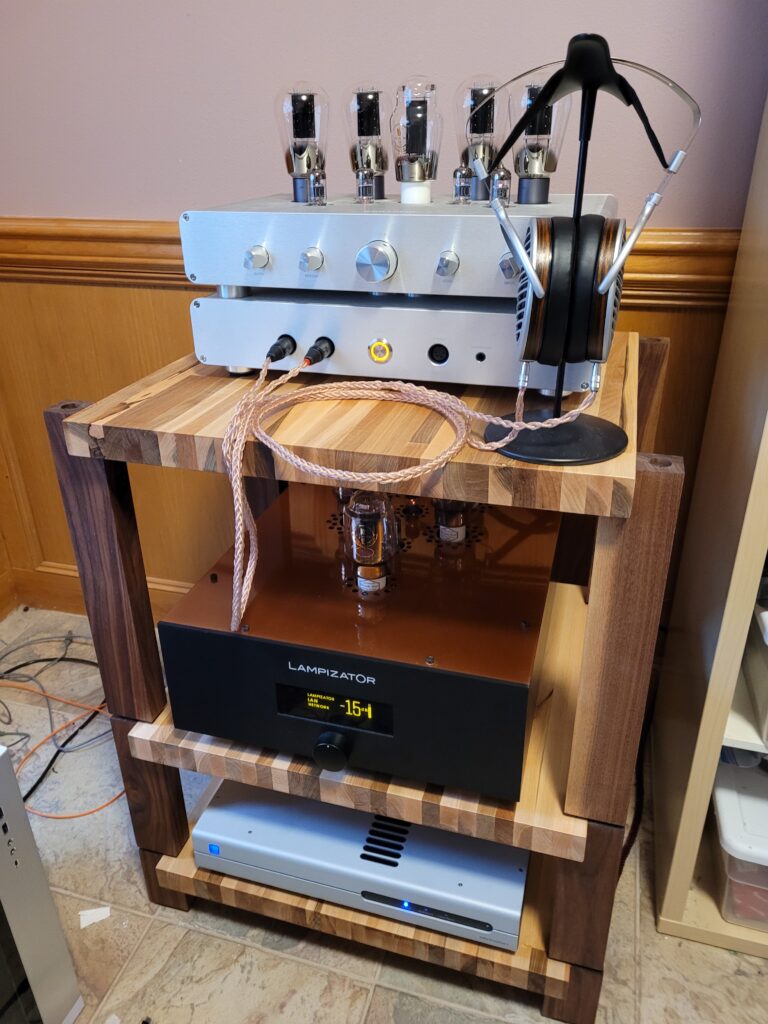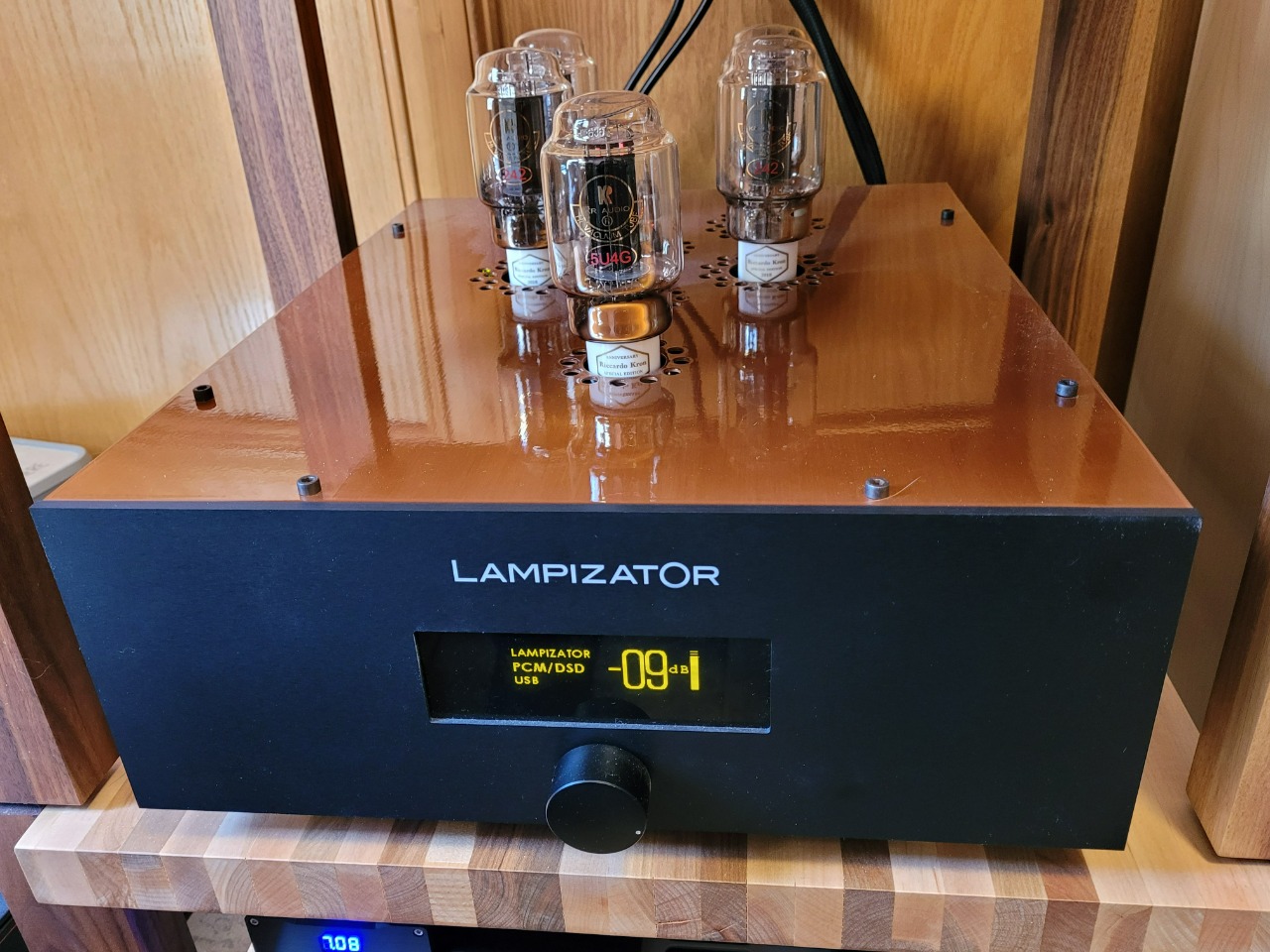I’ve resisted writing very much on the Pacific for a long time, there just aren’t that many people who are going to go out and buy one and I honestly can’t do a lot of competitive comps in a lot of detail.
Having said that I’ve recently seen a couple of used listings for SE units without the pre amp for not much more than a Dave+MScaler and at that price it deserves serious consideration by anyone considering something else.

Overview
Base price for a new Pacific from Lampizator North America is currently $27000, mine is a Balanced unit with the pre amp, coming in at a whopping $35700 list. Used prices however run about $0.50 on the dollar, occasionally a little less.
The DAC is huge 17 in x 7 in x 20.5 in (43 cm x 18 cm x 52 cm) + an additional 8 or so inches for the tubes sticking out of the top. It weighs in at 44lbs (20Kg). If you remove the top, it’s surprisingly crowded inside the unit, with the weight obviously coming from the various transformers.
Unlike earlier Lampizator’s that were largely R2R designs, the D/A conversion is done through a DS chip, Lampizator doesn’t state which one, the output section is all tube, and can take a variety of DHT tubes (discussed later).
It has the usual array of inputs (I’ll discuss these later) plus an ethernet port which is actually an off the shelf raspberry Pi running diet-pi and roon bridge, bridged to the USB input. This is not a solution endorsed by Roon, but actually works well, I actually flashed mine to use Ropieee after a bad roon release required roon bridge be re-installed, mostly because it’s easier to manage and update.
The optional preamp feature is a high quality relay based unit, and the output is hot enough with some tube combinations it’s certainly a nice to have.
The one arguably bizarre ergonomic thing on the Pacific is that the power/standby button is on the bottom of the unit, it’s not really an issue, you can use the remote, and it’s quite easily accessed when you know where it is. But it did lead to a few panicked minutes when I first powered it on and the display didn’t light up.
Aside the DAC’s I’ve owned
A few years ago I had a Topping D10, and a Schiit Modi, and I think it’s a fair question to ask how did you get here from there.
On my 2 Channel systems I’d always used physical transports, streaming wasn’t really something I did until I started getting into headphones, for brevity, I’ll skip the process of deciding headphones were worth the investment.
I actually owned a number of other <$300 DAC’s in my early experiments with headphone systems, frankly I could have lived with any of them, they were all “fine” and they were more alike that different. Yes I could hear a difference, but I really didn’t have clear preferences between them. And this held true even on my 2Ch system, and as the cost of the headphones and amps creeped up.
The first step on the road to DAC’s matter was a Schiit Gungnir, I was quite simply blown away by the improvements it showed over the SMSL SU8 I had been using, it was just plain better, though in ways that were difficult to articulate at the time. It was more resolving, produced a bigger better defined stage, bass was perceived (using that word intentionally) to be weightier, and treble seemed to extend further but without the associated harshness on the SU8.
Form there is was really about answering the question, if a $1200 DAC makes this much difference, what does a $3000 DAC sound like? You can can imagine the slippery slope from there. From the Gungnir I went to Lampizator Amber 3, from Amber 3 to Aqua LaVoce S3, from the Aqua to a Chord Dave, and from there to the Pacific.
When I finally bought the Pacific, I’d been looking for a balanced Lampizator Golden Gate for a while without finding one, the Pacific showed up, and in a moment of weakness I jumped.
Sound Signature
I think a lot of people expect Lampizator DAC’s to be “tubey”, they (at least the more modern ones) aren’t, you can hear the tubes, but the prevailing aspects of their sound to me are midrange weight and dynamics along with effortless detail. It’s a very organic, (I hate to say analog) sounding DAC.
I’ll talk about tube rolling separately, but it’s fair to say with any of the combinations of tubes I tried, the Pacific still sounded like the Pacific.
Perhaps the only interesting direct comparison I can give is against the Chord Dave.
I bought the Dave while I was looking for a used balanced Golden Gate. The price was right and I knew I could resell it at a minimal loss, it wasn’t a DAC I was expecting to love, but it really did grow on me. The Dave without a great digital source can come across thin sounding, adding either an MScaler or just a good AES source like the NS1 changes that character pretty dramatically for the better, and I can well imagine it being endgame for a lot of people. It also has great synergy with the WA33 IMO.
I had an overlap of several months where I owned both the Dave and the Pacific, I’ve been asked to compare them, and my somewhat pithy response has been it’s like the difference between an Amber 3 and an SU-8. What I really mean by that is signature preferences aside, there really isn’t anything the Dave does that’s at a comparable level to the Pacific. You might expect with the Lampizator’s tubes that the Dave to have an edge in resolution, but to my ears the Lampizator easily wins on that front. If you went with one of the less dynamic tube sets I could see an argument for the Dave being faster, with better impact, but IMO even that is a stretch. This impression was one of the reasons I resisted writing about the pacific, and why I found discussing the Gungnir so difficult when I first heard that, “it’s just better” is just not that useful an observation.
My impression over the years whether 2 channel or headphones is as gear generally moves up in quality you simply have less compromises. A lot of compromises you believe from your experience with other gear to be tied to certain aspects of a sound, simply don’t hold. You can have great treble extension and speed without harshness, great tonal weight without muddiness, stages can be expansive without feeling artificial.
Having said all that realistically at this price point, your probably looking if the signature matches your preference first and worrying about technicalities later. The Pacific is about an organic, dynamic presentation with good overall tonal weight.
Better comps than the Dave would probably be MSB, or some of the higher end DCS or Total DAC stuff. I just haven’t heard any of those for long enough to be able to compare them in detail.
Inputs
My particular Pacific has the older modified Amanero USB board, with a couple of expensive clock chips piggy backed onto it, newer ones have JL Sounds XMOS based boards, which have broader compatibility at the very least. Lampizator will swap the boards at a not unreasonable cost (just looking at the labor involved), but it requires shipping the DAC to Lampizator North America, and I’d rather not be without the DAC for an extended period or risk damage in shipping.
For the AES/SPDIF comparison I used an EMM Labs NS1 network bridge to provide the signal.
For USB I use a Sonore Optical Rendu, with an LPS. I have not tried directly connecting it to a computer.
Network, I tried both direct connection to my non audiophile switch, and using an optical bridge with a 6 inch ethernet cable into the Pacific’s Ethernet input.
Generally I preferred Network or USB over AES/SPDIF, though it wasn’t night and day, as I mentioned above the network connection just bridges to USB, so this probably speaks to quality of the clocks on the USB interface.
Network, optical vs direct ethernet to the switch, there was a win for the optical isolation, but it was subtle.
The USB from the optical Rendu was a marginal win over the network connections I tried.
Differences were subtle across the board, and I wouldn’t cry about having to use any of the inputs with a good source.
Tube Rolling
Tube rolling on a Balanced Pacific is an expensive endeavor.
However my Pacific shipped with about $10K in tubes, including several rectifiers and three sets of KR DHT tubes, a set of 242’s, a set of PX25’s and a set of T100’s (which should be close in sound to a 300B).
Unfortunately one of the rectifiers I really wanted to try (a Takatsuki 274B) was damaged in shipping.
In the end the rectifier choice came down to one of the two KR 5U4G’s, I got both the anniversary and SE versions with the unit, and I ended up using the SE (which I think is the better of the two) on the Pacific, and the Anniversary on my WA33.
On the Power tubes, it’s an interesting exercise, and while none of the tube sets really change the overall character of the DAC, there are pronounced differences, it’s really a sliding scale of dynamics and focus vs body and stage size. The 242’s are the most dynamic, the T100’s provide the most body and biggest stage, the PX25’s are in the middle.
My choice in my system was the 242’s, but it’s nice to have the options, and for me it was a close call between the PX25 and 242’s. The only other Pacific owner I know used PX25’s in his.
But does it make sense?
I certainly don’t regret my purchase and I’d like to hear the new Horizon DAC, but I have no real desire to jump to something else at this point. The DAC would be easier to justify if I used it for 2 Channel, but since I currently have no space for my 2 Channel system, it’s exclusively on my headphone rig.
If your not already looking at the Dave/MScaler price point, you’ll probably have to go through the convincing yourself it’s worth while stage. But if you are at that point in your journey, I’d certainly consider the small bump for a used base model Pacific.

My chains
Lampizator Pacific → Eddie Current Studio T→ MySphere 3.1/Focal Utopia OG/D8000Pro
TotalDAC D1 Unity → WA33 → Susvara/1266 Phi TC/Raal CA-1A
Some 2Ch stuff.
